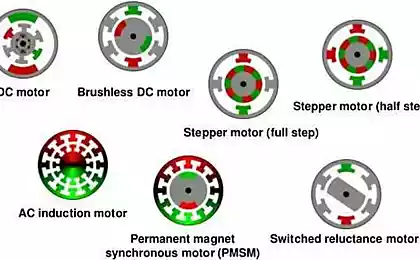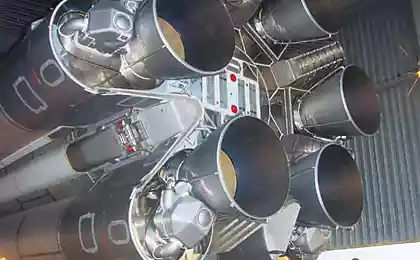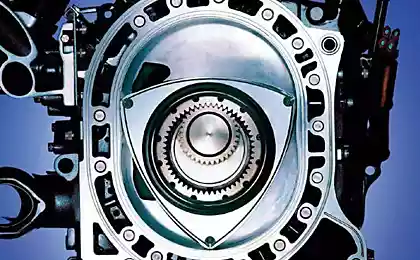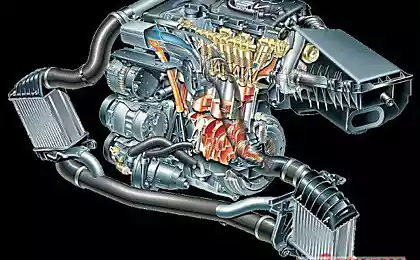What a rocket engine is the best?
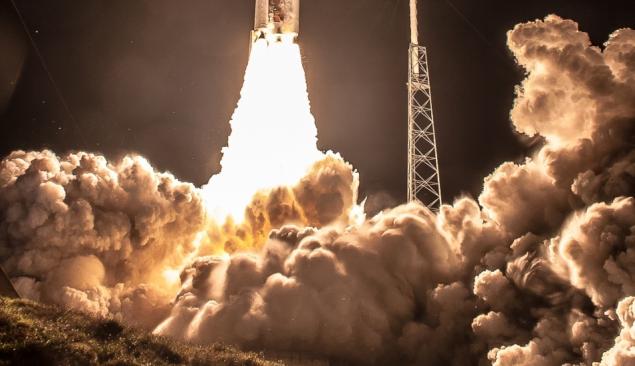
Rocket engines - one of the peaks of technological progress. Working at the limit of materials, hundreds of atmospheres, thousands of degrees and hundreds of tons of traction - it can not but admire. But a lot of different engines, some of them are the best? Whose engineers will rise to the podium? It's finally time with all sincerity to answer this question.
Unfortunately, the appearance of the engine can not say how wonderful it is. We have to dig in boring figures characteristics of each engine. But many of them, what to choose?
Stronger h4> Well, probably the more powerful engine, the better it is? More missiles more capacity, faster starts to move space exploration, is not it? But if we look at the leader in this field, we are waiting for some disappointment. The biggest attraction of all the engines, 1,400 tons, at the side of the accelerator Space Shuttle.
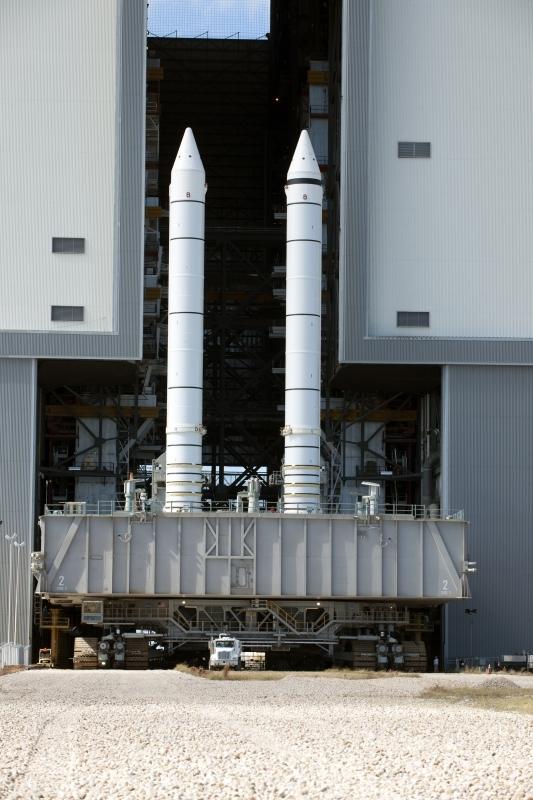
Despite all the power, solid-fuel boosters can hardly be called a symbol of technological progress, because structurally they are only made of steel (or composite, but it does not matter), the cylinder with the fuel. Secondly, these accelerators have died out with the shuttle in 2011, which undermines the impression of success. Yes, those who follow the news about the new American super-heavy launch SLS tell me that it is developing new solid fuel boosters, traction which will amount to 1,600 tons, but, first, fly the missile will not soon, not until the end of 2018 . And secondly, the concept of "take more segments with the fuel, draft is more" is the extensive way of development, if you wish, you can put more segments and gain even greater traction, the limit here is not reached, and quietly to the path led to technical excellence.
The second place on the domestic liquid keeps traction engine RD-171M - 793 tons.
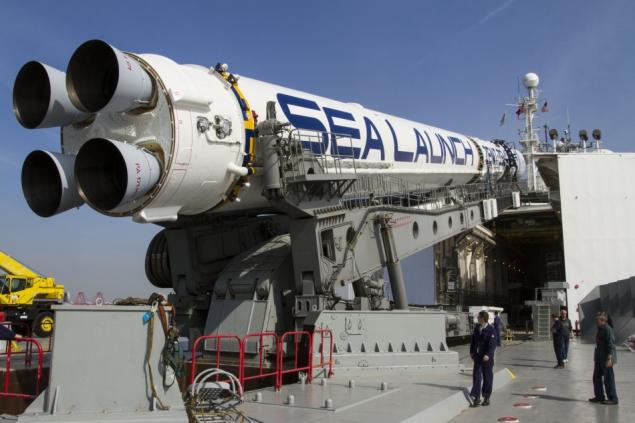
Four of the combustion chamber - a single engine. And a man for scale i>
It would seem - here it is, our hero. But if this is the best engine, where his success? Well, the rocket "Energy" was killed under the rubble of the collapsed Soviet Union, and "Zenith" finished off policy of relations between Russia and Ukraine. But why did the United States buy from us this remarkable engine, and half as much of the RD-180? Why RD-180 starts as a "half" of the RD-170 now provides more than half of the thrust RD-170 - as much as 416 tons? Strange. It is not clear.
The third and fourth place is occupied by traction motors with missiles, which are no longer flying. Solid UA1207 (714 tons), who was standing on the Titan IV, and the star of the lunar program an F-1 engine (679 tons) for some reason, did not help to survive until today, outstanding performance in power. Maybe some other important parameter?
More efficient h4> What determines the efficiency of the engine index? If the rocket engine burns fuel to disperse the rocket, then, the more effective he is doing, the less fuel we need to spend in order to reach the orbit / Moon / Mars / Alpha Centauri. The ballistics to assess the effectiveness of such a special option - the specific impulse.
The specific impulse shows how many seconds the motor can develop a thrust of 1 Newton on one kilogram of fuel blockquote>
Record for thrust are, at best, in the middle of the list, if it sort of specific impulse, and an F-1 with the solid boosters are deep in the tail. It would seem, here it is, the most important characteristic. But look at the leaders of the list. From 9620 index of seconds in the first place is a little-known electric propulsion HiPEP
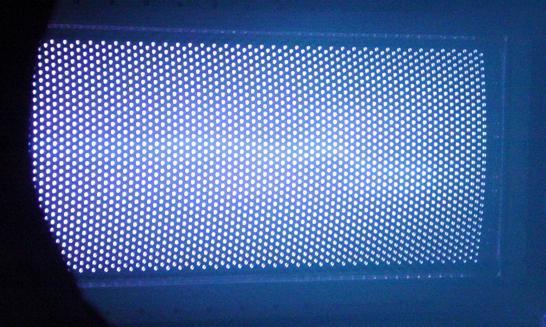
It does not fire in the microwave, but a real rocket engine. However, the microwave oven it still accounts for a very distant relative ... i>
HiPEP engine developed for the project closed a probe to study Jupiter's moons, and work on it was stopped in 2005. On the prototype test engine, as the official report says NASA, has developed a specific impulse 9620 seconds, consumes 40 kWh of energy.
Second and third places are occupied yet to fly electric propulsion VASIMR (5000 seconds) and NEXT (4100 seconds), showing their performance on a test bench. A fly in space engines (for example, a series of domestic engines of the SPD OKB "Torch") are figures up to 3000 seconds.
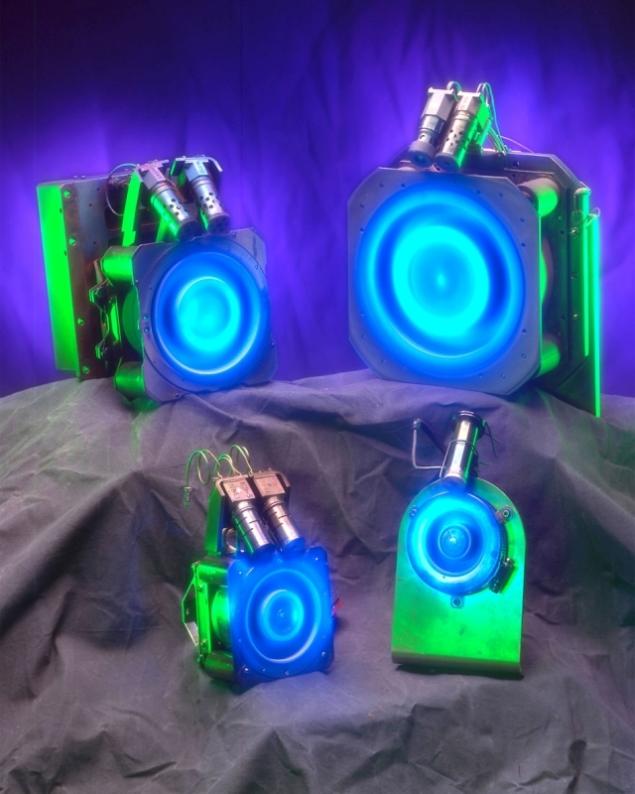
series engines SPD. Who said "great columns backlit»? I>
Why are these engines have not yet supplanted all others? The answer is simple, if we look at others their options. Traction electric jet engines is measured, alas, in grams, and in the atmosphere, they may not work at all. Therefore, to collect on these super-efficient engines, booster fail. And in the space they require kilowatts of power that not all satellites can afford. Therefore, the electric propulsion is used, mostly only on interplanetary stations and geostationary communication satellites.
Well, the reader will say, discard the electric propulsion. Who will be the champion on the specific impulse among chemical engines?
With the indicator 462 seconds in the lead among domestic chemical engines will KVD1 American and RL-10. And if KVD1 flew a total of six times in the composition of the Indian rocket GSLV, the RL-10 - a successful and respected engine for the upper stage and the boosters work fine for many years. In theory, you can collect the launcher entirely of such engines, but the thrust of the engine 11 tons means that the first and second stage they will have to put in tens, and willing to do so there.
Can I combine more thrust and high specific impulse? Chemical engines came up against the laws of our world (well, not burning hydrogen and oxygen with a specific impulse of more than 460 ~, physics forbids). There were projects of nuclear engines ( time , two ), but then the project is not yet gone. But, in general, when humanity will be able to cross a high thrust with high specific impulse, it will make the space more accessible. Are there any other indicators that can estimate the engine?
voltage h4> The rocket engine ejects mass (products of combustion or working fluid) to produce thrust. The faster it flies the most weight, the efficient engines it emits. And liquid rocket engines have a parameter which shows the effectiveness of the expiry of the combustion products - the pressure in the combustion chamber. The greater the pressure, the faster the molecule will fly combustion products. Engine with a higher pressure in the combustion chamber of the engine is more efficient at low pressure on the same fuel. And if we sort the list of engines according to the pressure in the combustion chamber, the podium will be occupied by Russia / the Soviet Union - in our design schools scrambled to make efficient engines with high performance. The first three places took a family of oxygen-kerosene-based RD-170: RD-191 (259 bar), the RD-180 (258 bar), the RD-171M (246 atm).
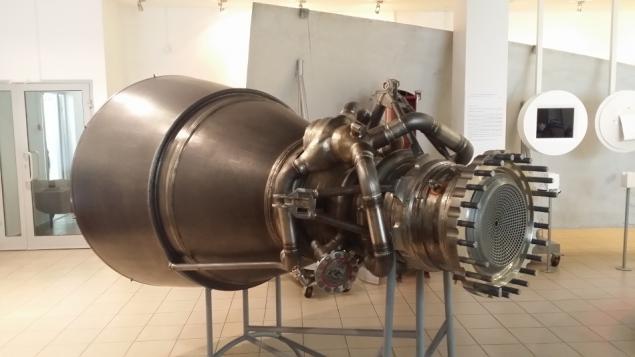
The combustion chamber RD-180 in the museum. Note the number of pins holding the cover of the combustion chamber, and the distance between them. It is clearly seen how hard it is to keep striving to disrupt the cover 258 atmospheres of pressure i>
Fourth place at the Soviet RD-0120 (216 atm), which holds the primacy among the hydrogen-oxygen engines and flew twice on the "Energia". Fifth place also with our engine - RD-264 to fuel a pair of unsymmetrical dimethyl hydrazine / nitrogen tetroxide in the PH "Dnepr" operates at a pressure of 207 atm. It was only in sixth place is the US Space Shuttle engine RS-25 with three hundred atmospheres.
reliability h4> Whatever the promise of engine performance, if it explodes through time, benefit from it a bit. More recently, for example, the company Orbital was forced to abandon the use of stored decades NK-33 engines with a very high performance because the accident at the test bench and the enchanting beauty of the night blast engine RN Antares questioned the appropriateness of the use of these engines on. Now Antares will be transplanted to the Russian RD-181.
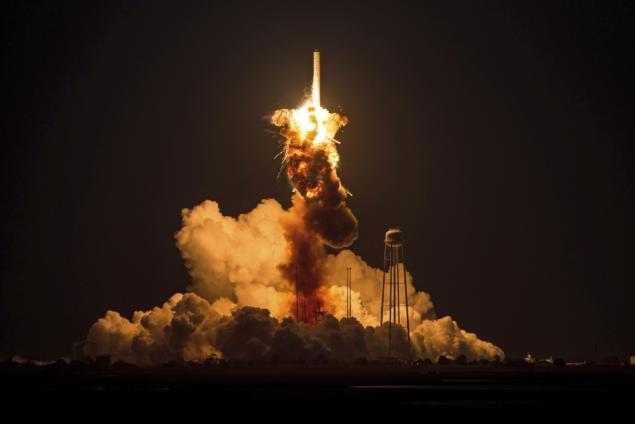
big picture по link i>
The reverse is true - the engine that does not differ outstanding values of thrust or specific impulse, but reliable, will be popular. The long history of the use of the engine, the more statistics, and the more bugs it had already happened to catch on accidents. RD-107/108, standing in the "Union", are descended from the very engines that launched the first satellite and Gagarin, and in spite of modernization, are quite low at present parameters. But high reliability largely pays for it.
Availability h4> The engine that you can not build or buy, does not have any value to you. This parameter can not be expressed in numbers, but it does not become less important. Private companies often can not buy ready-made engines at high prices, and are forced to make their own, albeit simpler. Despite the fact that those characteristics do not shine, this is the best engines for their developers. For example, the pressure in the combustion chamber of the engine Merlin-1D company SpaceX is only 95 atmospheres, a milestone that Soviet engineers have moved in the 1960s, and the United States - in the 1980s. But the mask can make these engines at its production facilities and to receive at cost price in the right quantities, dozens a year, and it's cool.
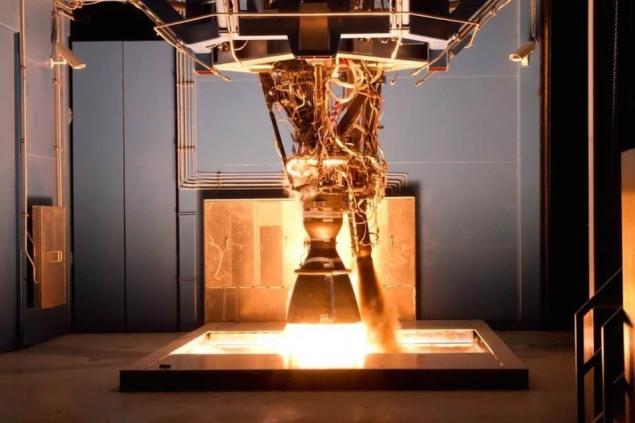
The engine Merlin-1D. The exhaust from the gas generator as "Atlas" Sixty years ago, but is available i>
TWR h4> Since we were talking about speyseksovskih "Merlin", not to mention the characteristics that strongly Force PR and fans SpaceX - thrust-weight ratio. Thrust-weight ratio (the same specific thrust or TWR) - is the ratio of thrust to its weight. On this parameter Merlin engine by a wide margin ahead of them it is above 150. At SpaceX website writes that it makes the engine "the most effective of all ever built", and this information is spread and the fans spin-doctors from other resources. The English Wikipedia was even a silent war, when this option to push, wherever they may be, which led to the fact that in the comparison table engines this column generally removed. Alas, in this application much more PR than the truth. In pure form, the engine thrust-weight ratio can be obtained only at the stand, and at the start of this rocket engines will be less than the percentage of its mass, and the difference in weight of the engine on what not affected. Despite the fact that the engine is high TWR more manufacturable than low, it is rather a measure of technical simplicity and unstressed engine. For example, the parameter engine thrust-weight ratio F-1 (94) exceeds the RD-180 (78), but the specific impulse and pressure in the combustion chamber of an F-1 is markedly inferior. And the thrust-to offer up on a pedestal as the most important characteristic for a rocket engine, at least naive.
Price h4> This parameter is largely due to the availability. If you do drive yourself, then it is possible to calculate the cost price. If you are buying, then this option will be explicitly specified. Unfortunately, this option is not to build a beautiful table, because the cost is known only to the producers and the cost of sales of the engine is also published not always. Also, the price effect, if the 2009 RD-180 was estimated at $ 9 million, but now it is estimated at $ 11-15 million.
Conclusion h4> As you have probably guessed, the introduction was written some provocative (sorry). In fact, no one rocket motor parameters on which they can build and clearly say which is the best. If we try to derive a formula better engine, you get something like this:
The best rocket engine - is a motor, you can make / buy , while it will have a thrust required you to a range of (not too big or small) and will be effective as ( specific impulse, the pressure in the combustion chamber ), his Price will not be too heavy for you. blockquote> Bored? But the closest to the truth.
And finally, a small hits engines, which I personally think is the best:
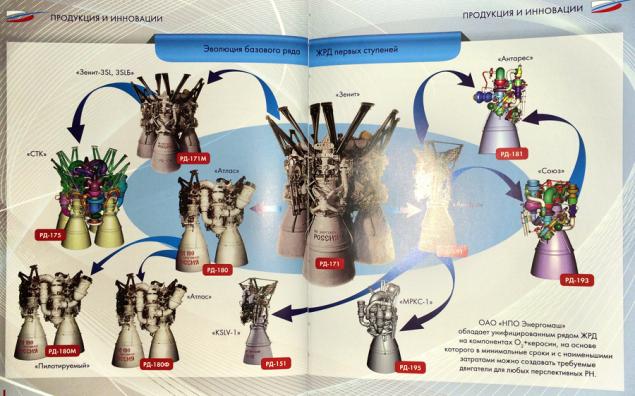
The family of RD-170/180/190
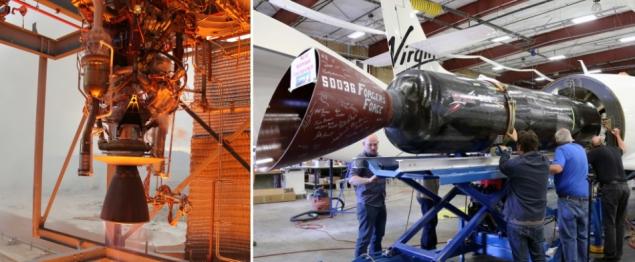
Be-3 and RocketMotorTwo
F-1 and J-2 h4> In the 1960s it was the most powerful engines in its class. And it is impossible not to like engines, gave us such beauty:
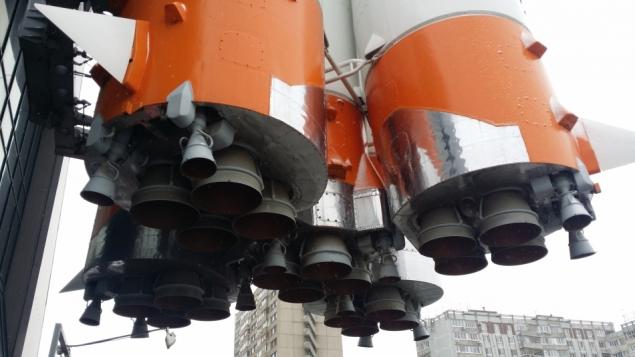
RD-107/108 «more stupid media» . Yes, of course, ever, and it will take time, but these engines will live another ten years at least, and it seems to set a record for longevity. Could not find a more successful engine with a glorious history.
Used sources h4>
The material is largely based on here this summary table of England wiki, there are trying to give a link to each digit and keep the material relevant. Full image KDPV with copyrights, which had cut the framing - here .
Related items for the tag «незаметные Difficulty ».
Source: geektimes.ru/post/270176/











